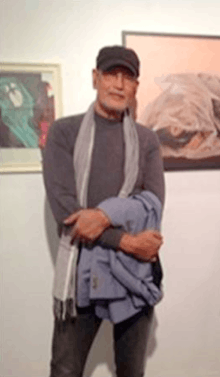Benedicto Cabrera
| Benedicto "Bencab" Cabrera | |
|---|---|
 BenCab in New York City | |
| Born |
Benedicto Reyes Cabrera April 10, 1942 Malabon, Rizal, Commonwealth of the Philippines |
| Nationality | Filipino |
| Education | University of the Philippines |
| Known for | Painting |
| Awards | National Artist of the Philippines |
Benedicto Reyes Cabrera (born April 10, 1942), better known as "BenCab",[1] is a Filipino painter and was awarded National Artist of the Philippines for Visual Arts (Painting) in 2006.[2] He has been noted as "arguably the best-selling painter of his generation of Filipino artists."[3]
Early life and education
BenCab was born to Democrito Cabrera and Isabel Reyes in Malabon, Philippines on April 10, 1942. He was the youngest of nine children.[2] BenCab's first exposure and discovery of the arts happened through his elder Brother Salvador, who was already an established artist during Bencab's childhood.[3]
He went on to study at the University of the Philippines, where he explored different art visual forms - photography, draftsmanship, printmaking - while honing his chosen craft as a painter. He received his bachelor's degree in Fine Arts in 1963.[2]
Family and European Career
BenCab met British journalist Caroline Kennedy in Manila in 1968, and married her in London in 1969.[3] The couple decided to stay in London. They have three children. The eldest, Elisar, was born in 1971 and is now a film and web series producer, married to award-winning playwright and web series writer, Lisa Gifford, based in London; Their middle child, Mayumi, was born in Manila in 1973 and became a successful model both in London and Los Angeles. She currently lives in Los Angeles with her partner, John A. Fries and their two children, Ronan (2011) and Ione (2013). Their youngest, Jasmine was born in 1977 and currently lives and works with BenCab at the BenCab Museum in Baguio.
Bencab's first years as a painter in London "were not particularly easy", but his talents were immediately recognized.[2] Over the next four decades, he established for himself a name of international importance, holding exhibitions from London to New York to Macau, and winning several major art awards in a career spanning four decades.[2][3]
When BenCab returned to the Philippines in 1972, he was hailed as a Filipino pioneer of the arts and a significant influence among his peers. However, he returned to London once more in 1974, partly to get away from the tightening grip of Martial Law, which Ferdinand Marcos had declared in 1972. That event is said to have "marked the beginning of [BenCab]'s passionate involvement with social commentary and the topics of repression and freedom.".[3] His Larawan series developed out of his nostalgia for the Philippines. He and Caroline used to scour local flea markets all over Europe looking for early maps and prints of the Philippines. This collection became the basis for his Larawan series.
In 1985, however, BenCab's 16-year marriage with Kennedy ended in divorce, and he eventually decided to come home to the Philippines.[4]
The Baguio Years
BenCab eventually returned to the Philippines, and settled in the City of Baguio in Northern Luzon, eventually putting up a studio and a secluded little farm on Asin road, in the nearby town of Tuba, Benguet. He and a small group of fellow artists - visual artist Santiago Bose, filmmaker Kidlat Tahimik, and sculptor Ben Hur Villanueva, among others, established the Baguio Arts Guild (BAG). It was during this period in his career that BenCab began to more deeply explore the use handmade paper as a medium on which to work.[3]
When the 1990 Luzon earthquake struck, BenCab and the BAG helped out by instituting programs such as the ArtAid workshop for traumatized children, and a fund-raising art auction they titled "Artquake." Bencab was elected president of the guild the following year.[3]
Later in the 1990s, BenCab's input was a critical element in the creation of Tam-awan Village, "a refuge for local artists who desire a nurturing environment in which to develop their talents, and a community for all those who wish to take part in the harmonious fusion of art, culture, environment, and history."[3]
BenCab also exhibited considerably during the last decade of the Millennium, also reaping many accolades. Among the most prominent of the many awards received by BenCab during this period was the Gawad CCP Para sa Sining (Cultural Center of the Philippines Award for the Arts) in 1992.[2]
National Artist and Recent Awards
In 2006, the Philippine Government conferred upon him the Order of National Artist for Visual Arts.[2] In 2009, the University of the Philippines conferred upon him an honorary Doctor of Humanities degree.[5]
Published Collections of Works
Four books covering BenCab's works have been released:[2]
- Ben Cabrera: Etchings (1970–1980) by Cid Reyes;
- Bencab’s Rock Sessions by Eric Caruncho;
- BENCAB by Alfred Yuson and Cid Reyes; and
- BenCab: Nude Drawings by Alfred Yuson.
References
- ↑ "The National Artists of the Philippines: Benedicto R. Cabrera". The National Committee for Culture and the Arts Website. National Committee for Culture and the Arts. 2008. Retrieved 2009-08-09.
- 1 2 3 4 5 6 7 8 "National Artist". BenCab Museum Website. BenCab Art Foundation. Retrieved 2009-08-08.
- 1 2 3 4 5 6 7 8 Andy Zapata Jr. (2003). "Homegrown: Profile of Ben Cabrera". HOMEGROWNART.NET. Jennifer Lapira. Retrieved 2009-08-08.
- ↑ Marge C. Enriquez (2009-05-19). "How tai chi brings out BenCab's creativity". Philippine Daily Inquirer.
- ↑ Regidor, Anna Kristine. "BenCab comes home.". UP Diliman Information Office. Retrieved 23 February 2012.
